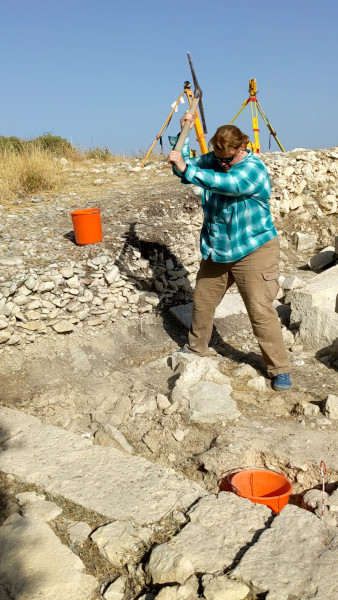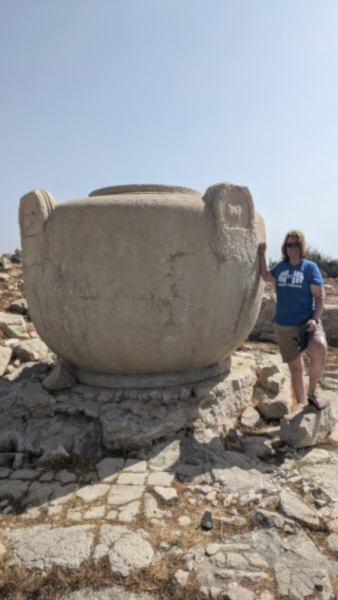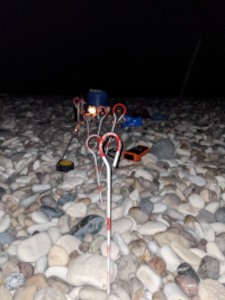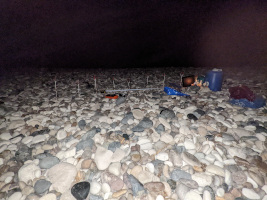
Illuminating the Invisible
This summer, I had the privilege of spending my seventh excavation season in Cyprus with the Kourion Urban Space Project under the direction of Drs. Tom Davis and Laura Swantek. Our goal for the season was to reach floor level and better define the relationship between the 5×5 meter trenches of Building 4, a building we began excavating in 2013. Our first week of work consisted of pulling weeds and cleaning the site. We had 4-6 years of brush growth to clear away. During our second week of work, we removed the baulks between the trenches, which was very enlightening. We discovered that “rooms” were not rooms, and walls bound spaces we thought were open. We also found that one area of the building was entirely paved by mosaic and marble floors and featured vine and floral painted plaster motifs. We also had an exciting discovery of a marble statue of a boy with a duck.


I had a few personal research goals that I wanted to persue while I was in Cyprus. My dissertation focuses on using exterior lights in the ancient world, and I’m using Kourion as a test subject. While it will be possible to test light and distance with a mathematical formula and computer model, there is something to be said about seeing is believing. So I attempted a little experimental archaeology; with my scholarship money, I was able to purchase equipment and supplies to experiment with light, distance, moonlight, and visibility.
My initial theory was that I would be able to see and measure the amount of light visible from the cliff to the beach. I had project members stand on the cliff, don’t worry, they were on a paved overlook, and a partner and I went down to the beach. Unfortunately, the first time we tried it, the wind was blowing too hard and blew out the candles. And we started too early in the evening before it was suitably dark. On our second attempt a few days later, we went to the cliff and beach after dark; there was less wind this time. I could see the candlelight from the beach; however, my light meter was too far away to pick up a reading. I made one final attempt at the end of the season late at night, around midnight to 1 A.M. It was just past a full moon, so I had plenty of natural light. This time I decided to see the base brightness level and how dim the light declined as I moved further away from my light source. I set up my candles and my tape measure, and I took a reading of one burning candle every 10 cm.
On my final attempt, I got a scaled measurement of a burning candle in bright moonlight! My first two attempts were failures, but as Thomas Edison said, “the light bulb was an invention with 1000 steps.” I’ll be able to plug this information into a formula and calculate how much light Kourion’s ancient inhabitants would require to be visible from the sea. My next experimental archaeology step will be to create torches and measure how much light they provide.
So why is this important? Light is easy for us. We flip a switch, turn on our phones, clap, light a match, or wave a hand. We are constantly in artificial light, so we do not think about the work that goes into illuminating a space. But there are drawbacks to working with light. For example, ancient light sources existed to be destroyed. Oil reservoirs burn out; wicks turn to ash; torches are made of wood and do not survive. So in some respects, I am chasing the invisible, but life did not stop for ancient people when the sun went down, and everybody went home and went to bed. There is too much evidence that this is untrue. But were people illuminating their cities? I think they were. People use light to establish their presence: Eifel Tower, city skylines, Las Vegas, or Jesus’ reference in Matthew of “a city on a hill” (Matthew 5:14). People use light to see and to be seen; they had to illuminate their city with artificial light. It was a statement of power, wealth, and a marker of civic identity. And for Kourion, I think this is key for understanding why they built on the acropolis where there was no natural water source.
Rebekah Ross is a senior Ph.D. student at Lipscomb University. She has been working with the Kourion Urban Space Project since its inception in 2012. Her research interests include light, illumination, lamps, and ancient glass.
Press release for the 2022 Kourion Urban Space Project Field Season.
American Society of Overseas Research
The James F. Strange Center
209 Commerce Street
Alexandria, VA 22314
E-mail: info@asor.org
© 2023 ASOR
All rights reserved.
Images licensed under a Creative Commons Attribution-NonCommercial-ShareAlike 4.0 International License
COVID-19 Update: Please consider making payments or gifts on our secure Online Portal. Please e-mail info@asor.org if you have questions or need help.


